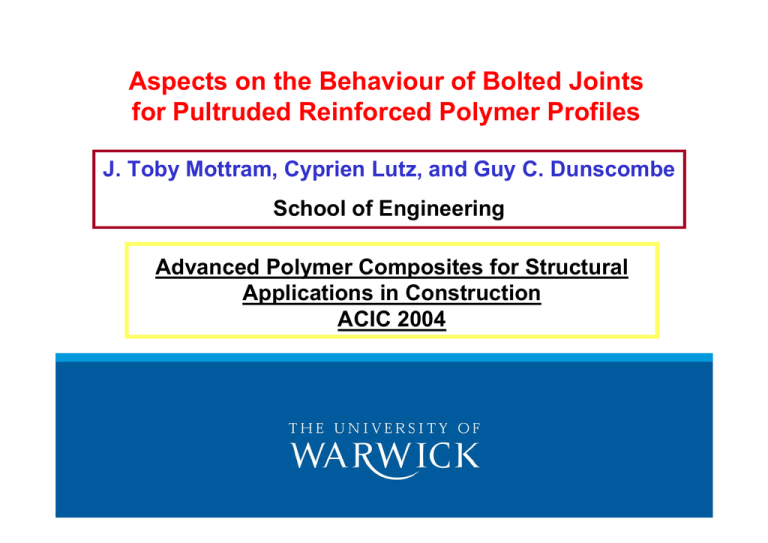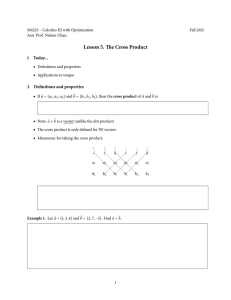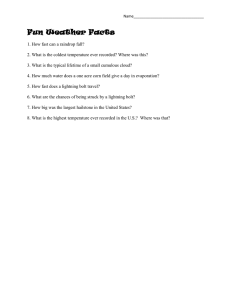Aspects on the Behaviour of Bolted Joints School of Engineering
advertisement

Aspects on the Behaviour of Bolted Joints for Pultruded Reinforced Polymer Profiles J. Toby Mottram, Cyprien Lutz, and Guy C. Dunscombe School of Engineering Advanced Polymer Composites for Structural Applications in Construction ACIC 2004 PFRP Bolted Plate-to-Plate Joints Design Approach SIMPLISTIC LEVEL Ultimate joint strengths S Creative Pultrusions Inc. for cleated beam connections (SF = 4) – Knock-down factors (for hot/wet conditioning, etc.) W/D = 3 E/D = 7 W/D = 7 E/D = 5 W/D = 10 E/D = 2 E P – Minimum joint dimensions (for “bearing” failure; RT) – Load tables (Fiberline Composites (SF = 3 (?)) and P D Pultrusion direction W P is Pitch S is Side distance Net-tension Shear-out EXTREN 525 flat sheet 1/4 inch Motivation - Bolted Joint Variables 1700+ concentric load joint tests 810 single and 900 multi-bolted (RT, hot, wet, and hot/wet) 11 test centres choose different variables to study 62% of total tests at Lancaster Univ. and Warwick Univ., UK Variables in blue not studied previously: • type of loading (e.g. stroke or load control, by-pass load). • materials (bolts and PFRP). • plate thicknesses and fibre orientations. • joint geometries. • bolt arrangements (washers, torque, and clearance holes). • serviceability (SSL) loading (creep and cyclic). • working environment (e.g. hot/wet, etc.). Constant Load Tests - Method PURPOSE -- To find out if resistance changes by how the load is applied E P D Bolt force P Concentric load Tensile load S 3x3 joint, EXTREN Series 625 of 6.35 mm thickness, load in direction of pultrusion. M10 bolts of steel grade 8.8, D = 10 mm (hole clearance 0.1 - 0.3 mm). Two groups E/D = 6 and P/D = 4 constant; first S/D = 2 and second S/D = 4. Torque finger tight (< 3 Nm). Load rate at 0.3 kN/s to 80% of the 100% stroke control ultimate load. 10 mins constant load, then load increased by 5% to 85 %, held constant for 10 mins, repeat procedure until ultimate joint failure. Load (kN) Constant Load Tests - Results 90 80 70 60 50 Ultimate failure 7-D12 1-D11 3-D10 40 30 20 10 0 -10 1-D7 1-D6 0 500 1000 1500 2000 Time (S) Mode of failure is net tension at first bolt row - same in stroke control (0.01 mm/s). S/D = 4, four specimens failed when load is 90% and two failed at 95% of 72 kN. S/D = 2, three specimens failed at 90% and at 95% of 85 kN. The 100% ultimate load is the minimum from three stroke controlled tests. Stroke controlled resistance can be 10% higher than when load is kept constant for only 10 minutes. Bolt Torque and Load Transfer by Friction - Test Method PURPOSE -- To determine coefficient of friction for load transfer by shear 0.2 mm clearance > 2mm clearance hole 6.35 mm thick Fixed side Slip side 116 mm 360 mm PFRP on PFRP Slip side hole clearance is 4 mm for inner 9.53 mm thick plate M12 and M16 bolts and washer diameters are 24 and 29 mm Stroke rate is 1 mm/min Bolt tension measured by load cell Bolt Torque and Load Transfer by Friction - Results 20 18 Slip starts 16 14 Load (kN) Increasing 10 kNmm 20 kNmm 30 kNmm 40 kNmm 50 kNmm torque 12 10 8 6 4 Bolt bearing 2 0 0 1 2 3 4 Stroke (mm) Load-stroke curves for M12 bolting and increasing torque Bolt Torque and Load Transfer by Friction - Results 20 Bolts were not lubricated M12 Slip Load (kN) 15 M16 M16 trendline 10 M12 trendline Torque applied to M16 bolt head, poor method! 5 0 0 10 20 30 40 50 60 Bolt torque (kNmm) Load-slip results with scatter bars and trendlines (intercept is 0, 0) Bolt Torque and Load Transfer by Friction - Results Approximate coefficient of friction for PFRP on PFRP is: 0.22 with the M12 bolting 0.14 with the less reliable M16 bolting. In design can we rely on friction to transfer joint loading? Testing does not account for bolt tension relaxation (20% in one week). Allowable bolt torque for the bolt tension not to exceed 75% of the steel’s proof strength might lead to compressive crushing of PFRP. Preliminary calculations indicate that a joint design procedure neglecting bolt bearing cannot be developed. Conclusions • Test series with PFRP plate-to-plate bolted joints have been used to investigate two variables previously not studied. • Under constant load the resistance of 3x3 multi-bolted joints is found to be less than that determined by testing under stroke control. • The coefficient of friction for PFRP on PFRP has been found to be about 0.2 (new tests with lubricated M16 bolts gives 0.27 - the lubrication increases the bolt tension per unit torque). • The low coefficient of friction of 0.14 with M16 bolting shows by how much bolt tension can be changed by the method used to apply the bolt torque. • Preliminary work indicates that a joint design procedure cannot be developed which relies on the entire joint force being carried by friction. Thank you for your attention Any questions? Email: jtm@eng.warwick.ac.uk



